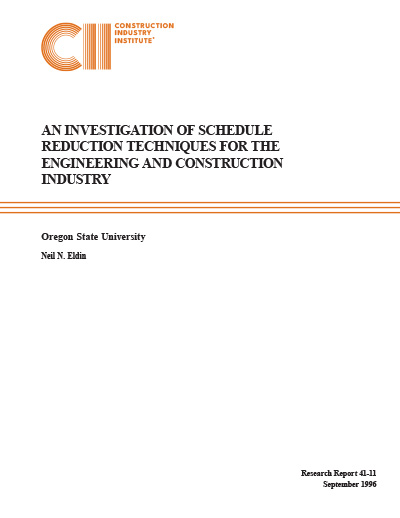
Schedule Reduction
Owners are demanding higher quality in their construction projects, and that the projects be delivered at lower costs and within shortened durations. Recent research by CII reveals that meeting such demands is possible, and that using specific schedule reduction techniques can assist in reducing project durations without escalating total installed cost.
The Construction Industry Institute established three broad industry goals for the Year 2000: reduce total project costs by 20 percent, reduce project schedules by 20 percent, and improve recordable accident rates by 25 percent. In pursuit of the second of these three goals, CII established the Schedule Reduction Research Team. The purpose of the team was to investigate the efforts by the engineering and construction industry and other industries in the use of techniques that can bring about reductions in project duration. This publication is a summary report on the research.
The team examined case studies of successful projects, which showed that the following five techniques are highly effective in reducing project durations:
- Freeze of project scope
- Constructability
- Concurrent engineering
- Cycle time analysis
- Use of electronic media
The team found that the use of techniques to reduce product delivery time is much more prevalent in industries where the work environment is much more controlled compared to the construction industry. No schedule reduction techniques, however, are unique to the other industries. Also, it was rare for a single technique to be used in isolation. What is important to note about schedule reduction techniques in the construction industry is that the working environment in which they are used is the most critical factor. Such an environment generally has management commitment and support for using the schedule reduction techniques, cross-functional teams with both technical and interpersonal skills, and good lines of communication among all project participants.
Changes to the scope of a project beyond the final authorization inevitably result in longer duration and higher costs. Freezing of scope allows detailed design and material procurement to progress rapidly without rework and inefficiencies; and results in better budget accuracy with lower overall costs. Conceptual design and project definition should have progressed to the point that the authorization (definitive) cost estimate can be developed.
Evaluation of alternatives, value engineering, constructability input, and safety reviews should be completed before the scope is frozen. An effective change control process must also be in place. Team factors include a high level of trust among the owner, contractor, and other team personnel; inclusion of a user representative; and commitment to avoid scope growth, even if funds are available. Subdivision of the project into smaller components produces quicker and more concise definitions, resulting in shorter durations. Resistance to changes after a scope freeze must be driven by the owner Management. Costs for implementation of process changes that support early freeze should be weighed, but are usually relatively small. (RS41-1, p. 4)
Concurrent engineering changes the traditional engineering approach in two basic ways:
- End users and other project team members are actively involved in engineering activities as they are conducted, eliminating the need for formal end-of-activity reviews.
- Subsequent tasks are started earlier as bits of information become available, due to ongoing reviews and decision-making.
The following factors that can reduce project durations have been identified:
- Team members are responsible for the total project life cycle.
- Cross functional teams represent all major stakeholders.
- Early involvement of end-users in the design process.
- Aggressive schedules with monthly objectives and clear communication.
- Electronic software allows design groups to access common data.
Cycle time analysis is a formal review to ensure delivery of exactly what is needed, when it is needed, and the amount needed, while eliminating unnecessary activities from all functions of an organization. It can be used successfully in any phase of a project, and most effective when used with other schedule reduction techniques. The following practices are included:
- Form a cross-functional steering team of key stakeholders under the leadership of the project manager.
- Select a target process or focus area. Examples: inventory reduction, paperwork routing/approval, just-in-time manufacturing, or innovative construction sequences.
- Form teams for selected work areas and provide training in team dynamics and techniques.
- Map the overall work processes and identify problem areas (unnecessary steps, inconsistent handling, duplicated work, shared information, etc.).
- Select performance indicators, then measure, chart and post in each work area.
- Communicate the goals and progress of the analysis to employees involved with the process and provide them with necessary retraining.
- Use technology to provide common databases and automate information transfer and transactional type activity. (RS41-1, p. 18)
Use of more sophisticated EDM (electronic data management) technologies such as 3-D CADD and document imaging is likely to be commonplace in the near future. Maintaining a competitive edge, market expansion, increased productivity, and profit, will dictate that EDM tools become imperative. But they won’t produce successful projects unless good processes are in place for the project as a whole. EDM tools work well when used in conjunction with other SRTs (schedule reduction techniques): concurrent engineering, freeze of project scope, and cycle time analysis. Benefits include:
- Multi-locational access to process information
- Elimination of departmental ownership of information
- Improved process efficiency as demonstrated by reduced process cycle times
- Improved customer-supplier relations
- Access to real-time process information
RS41-1, Impact of Schedule Reduction Techniques over Project Life Cycle, (Appendix A)
- Based on the research team’s experience, a c)hart was developed showing the relative impact of a particular schedule reduction techniques (SRT during typical project life-cycle phases.
RS41-1, Deliverables Required Prior to Freezing Project Scope, (Appendix B)
- Early freezing of scope is valid for all projects, regardless of type or size.A structured process is needed for freezing of project scope to ensure all required deliverables are completed.


